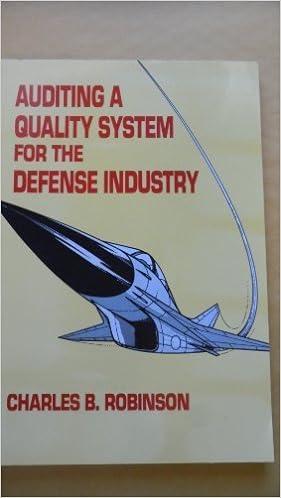Question
Over the past several years, decommissioned U.S. warships have been turned into artificial reefs in the ocean by towing them out to sea and sinking
Over the past several years, decommissioned U.S. warships have been turned into artificial reefs in the ocean by towing them out to sea and sinking them. The thinking was that sinking the ship would conveniently dispose of it while providing an artificial reef environment for aquatic life. In reality, some of the sunken ships have released toxins into the ocean and have been costly to decontaminate. In the late 1990s, at least two international conventions have made it all but impossible to export used warships for salvage without removing all military equipment, conducting a complete cleanup and cutting the ship into such comparatively small pieces as to make the entire exercise relatively expensive.
The new environmental regulations have made disposal of ships an expensive project. The United States has hundreds of mothballed warships, presenting an extremely expensive problem for military authorities and the government. Now the U.S. government is taking bids to instead dismantle and recycle ships that have recently been decommissioned (but have not been sunk yet.)
Assume that a recently decommissioned aircraft carrier, the USS Blaze, is estimated to contain 40 tons of recyclable materials able to be sold for approximately $32.8 million. About 90% of the value in old ships is the metals, including steel, copper, copper alloys, and lead that can be removed, sold for remelting, and reformed into new metal products. There are also some high-value metals; such as, nickel alloys, stainless steel, and titanium that can be found in some parts of all warships but may be present is such small quantities that recovery and resale may not be cost effective. The low bid for dismantling and transporting the ship materials to appropriate facilities is $34.5 million. Recycling and dismantling the ship would create about 500 jobs for about a year on the West Coast area. This geographic area has been experiencing record-high unemployment rates in recent years.
As an alternative, reefing these ships would create new habitats for underwater life and can be done using newer environmentally safe methods. These new artificial reefs would enhance fishery resources and facilitate the access and utilization by recreational and commercial fishermen. Artificial reefs can also increase tourism by attracting sport divers for recreational purposes. Academic organizations may be interested in using the site to study fish and other marine life which may open the door for more funding from these research activities. Research has shown that a new reef will attract 60,000 70,000 divers and add more than 10 million to the local tourism industry. Research has also shown that artificial reefs can substantially increase the population of reef-associated species. Within months the G. B. Church artificial reef in British Columbia had hundreds of encrusted individuals on its hull and within 2.5 years had seen an increase of nearly 100 species.
Reefing the ship would cost an estimated 800K (or $0.8 million) which includes cleaning of the vessel of toxics, oils and greases, PCB containing electrical and electronic equipment and other readily removable PCB containing equipment, local towing and docking, preparation (unspecified) and other incidental overhead items, insurance, and making the vessels safe for divers (diverizing). There will also be yearly maintenance costs in perpetuity.
1. Is it more financially advantageous to sink the ship or to dismantle and recycle it? Show your calculations. (Worth 4 pts.)
Recycling=$32,800,000
Dismantle and transport=$34,500,000
Reefing the ship= $800,000
To dismantle and recycle the ship would cost, 34,500,000-32,800,000=$1,700,000, while sinking/reefing the ship would cost $800,000. This means that it would be more financially advantageous to sink or reef the ship because it would save a total of $900,000.
2. From a sustainability standpoint, what should be done with the decommissioned aircraft carrier? (Worth 4 pts.)
3. List some of the other quantitative and qualitative factors that should enter into this analysis. (Worth 10 pts.)
4. As a taxpayer(s), which action would you prefer (sink or recycle)? Defend your answer. (Worth 4 pts.)
Step by Step Solution
There are 3 Steps involved in it
Step: 1

Get Instant Access to Expert-Tailored Solutions
See step-by-step solutions with expert insights and AI powered tools for academic success
Step: 2

Step: 3

Ace Your Homework with AI
Get the answers you need in no time with our AI-driven, step-by-step assistance
Get Started


